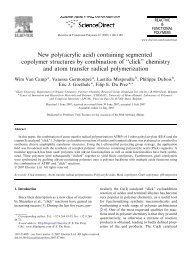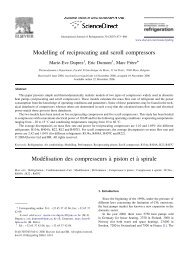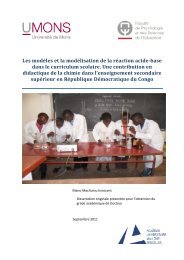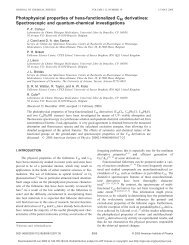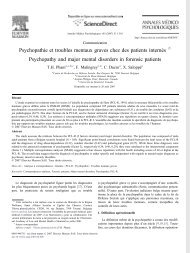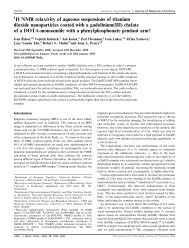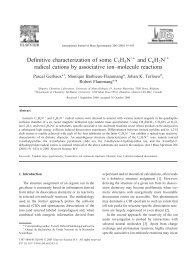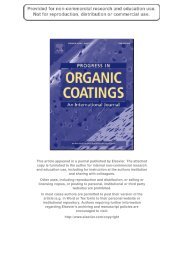Morphology and rheology of poly(methyl methacrylate)-block-poly ...
Morphology and rheology of poly(methyl methacrylate)-block-poly ...
Morphology and rheology of poly(methyl methacrylate)-block-poly ...
- No tags were found...
You also want an ePaper? Increase the reach of your titles
YUMPU automatically turns print PDFs into web optimized ePapers that Google loves.
1254 J. D. Tong et al.Fig. 4. Temperature dependence <strong>of</strong> the shear storage modulus(G9) for a series <strong>of</strong> MIM tri<strong>block</strong>s at 1 Hz (heating rate: 28C/m).For the sake <strong>of</strong> clarity, curves have been vertically shifted withrespect to sample 2 (sample 1 downwards by 0.5 unit; samples3, 4 <strong>and</strong> 5, upwards by 0.5, 1.0 <strong>and</strong> 1.5 units, respectivelyture tested. It is known that G9 measured at low frequenciesdecreases sharply at or near the order-disorder transitiontemperature (T ODT ) <strong>of</strong> the <strong>block</strong> co<strong>poly</strong>mer 20 – 23) . It isthus obvious that a phase-separated morphology persistsbeyond the glass transition <strong>of</strong> the PMMA microdomains<strong>of</strong> samples 3 to 5, at least up to 2008C. The comparison<strong>of</strong> MIM <strong>and</strong> SIPS <strong>of</strong> comparable molecular structure(sample 4 <strong>and</strong> Kraton D1107), also shows that G9 starts todecrease only at 1208C for MIM, which is ca. 208Chigher than for the SIPS sample, in agreement with ahigher service temperature for the MIM tri<strong>block</strong> co<strong>poly</strong>mer.Relaxation at temperatures beyond T g <strong>of</strong> PMMAThe rheological properties <strong>of</strong> <strong>poly</strong>mers are closely relatedto the relaxation process <strong>of</strong> the <strong>poly</strong>mer chains. Recently,Berglund <strong>and</strong> McKay have thoroughly studied the relaxationbehavior <strong>of</strong> SIPS tri<strong>block</strong> co<strong>poly</strong>mers 19) . The completerelaxation stress proceeds in two steps:diffusion <strong>of</strong>the outer <strong>block</strong>s out <strong>of</strong> the microdomains, followed bydiffusion <strong>of</strong> the released chains through the entangledmid<strong>block</strong> chains. Fig. 5 compares the relaxation for twoMIM tri<strong>block</strong>s <strong>of</strong> different PMMA molecular weight(samples 1 <strong>and</strong> 3) but <strong>of</strong> the same spherical morphology.The relaxation curve for the MIM containing PMMA<strong>block</strong>s <strong>of</strong> 7000 MW clearly confirms Berglund <strong>and</strong>McKay’s conclusion, i.e. a two-step drop <strong>of</strong> G(t) in the10 –1 l10 1 s <strong>and</strong> 10 1 l2610 2 s regions, respectively,assigned to the relaxation <strong>of</strong> the PMMA <strong>block</strong>s out <strong>of</strong> theFig. 5. Time dependence <strong>of</strong> the stress modulus for two MIMtri<strong>block</strong>s (samples 1 <strong>and</strong> 3, in Tab. 1)hard microdomains followed by the diffusion <strong>of</strong> the entirechains through the PIOA matrix. The relaxation <strong>of</strong> MIMcontaining two times shorter PMMA <strong>block</strong>s is quite reminiscent<strong>of</strong> that one commonly observed for monophase<strong>poly</strong>mers, so indicating that no microdomain structurepersists at 1308C.Dynamic frequency sweep experimentsFig. 6 illustrates how the complex viscosity <strong>of</strong> sample 2depends on the angular frequency. The complex viscosityat 1208C is clearly non-Newtonian, as is the case for vulcanizedrubber. A yield behavior starts to be observed at1808C, <strong>and</strong> a Newtonian behavior at low shear rate, aswell. The observation that the Newtonian behaviorbecomes more pronounced as the temperature isincreased beyond some limit, is the signature <strong>of</strong> the completerelaxation <strong>of</strong> the tri<strong>block</strong> chains at low angular frequencywhen T ODT <strong>of</strong> the <strong>block</strong> co<strong>poly</strong>mer isapproached 19) . Fig. 7 compares the plots <strong>of</strong> complex viscosityvs. angular frequency for a series <strong>of</strong> MIM tri<strong>block</strong>sat 1708C. As the PMMA molecular weight is increased,the non-Newtonian behavior is continuously more pronounced,as a result <strong>of</strong> increasingly more extended phaseseparation when the molecular weight 24) is increased.Fig. 8 compares the complex viscosity <strong>of</strong> MIM/MI binaryblend (sample 9, Tab. 1) <strong>and</strong> Kraton D1107. It mustbe noted that although the MIM/MI binary blend containsthe same di<strong>block</strong> content as the Kraton co<strong>poly</strong>mer, thecontent <strong>of</strong> the hard <strong>block</strong> (ca. 11.5 wt.-%) is smaller comparedto Kraton (ca. 15 wt.-%). Moreover, the molecularweight between chain entanglements (M e ) is 60000 forPIOA 6) much higher than the 6100 for PIP 2) . For these



